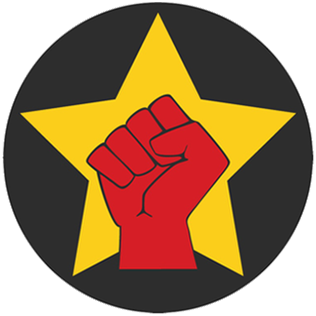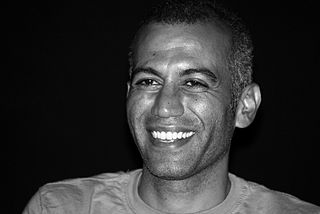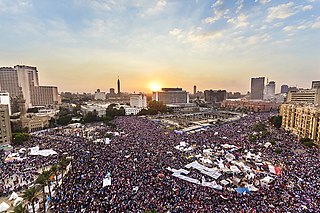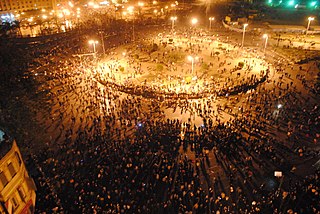Related Research Articles
Intifada is an Arabic word for a rebellion or uprising, or a resistance movement. It can be used to refer to an uprising against oppression.

Muhammad Hosni El Sayed Mubarak was an Egyptian politician and military officer who served as the fourth president of Egypt from 1981 to 2011.

Tahrir Square, also known as Martyr Square, is a public town square in downtown Cairo, Egypt. The square has been the location and focus for political demonstrations. The 2011 Egyptian revolution and the resignation of President Hosni Mubarak occurred at the Tahrir Square.

The 2011 Egyptian revolution, also known as the 25 January Revolution, began on 25 January 2011 and spread across Egypt. The date was set by various youth groups to coincide with the annual Egyptian "Police holiday" as a statement against increasing police brutality during the last few years of Hosni Mubarak's presidency. It consisted of demonstrations, marches, occupations of plazas, non-violent civil resistance, acts of civil disobedience and strikes. Millions of protesters from a range of socio-economic and religious backgrounds demanded the overthrow of Egyptian President Hosni Mubarak. Violent clashes between security forces and protesters resulted in at least 846 people killed and over 6,000 injured. Protesters retaliated by burning over 90 police stations across the country.
International reactions to the Egyptian revolution of 2011 refer to external responses to the events that took place in Egypt between 25 January and 10 February 2011, as well as some of the events after the collapse of the government of Egyptian President Hosni Mubarak, such as Mubarak's trial. The reactions have generally been either measured or supportive of the Egyptian people, with most governments and organisations calling for non-violent responses on both sides and peaceful moves towards reform. Whilst the protesters called for Mubarak to step down immediately, most foreign governments stopped short of this demand, at least during the early phases of the protests, due to realpolitik concerns about the consequences of a power vacuum on Egyptian stability in particular and to the wider Middle East as a whole. Some Middle Eastern leaders expressed support for Mubarak. Many governments issued travel advisories and evacuated foreign citizens from the country.

The Revolutionary Socialists (RS) are a Trotskyist organisation in Egypt originating in the tradition of 'Socialism from Below'. Leading RS members include sociologist Sameh Naguib. The organisation produces a newspaper called The Socialist.

The Egyptian Crisis was a period that started with the Egyptian revolution of 2011 and ended with the beginning of the presidency of Abdel Fattah el-Sisi in 2014. It was a tumultuous three years of political and social unrest, characterized by mass protests, a series of popular elections, deadly clashes, and military reinforcement. The events have had a lasting effect on the country's current course, its political system and its society.

The 2011 Iraqi protests came in the wake of the Tunisian revolution and 2011 Egyptian revolution. They resulted in at least 35 deaths, including at least 29 on 25 February 2011, the "Day of Rage".

The following is a chronological summary of the major events that occurred during the Egyptian Revolution of 2011, after Hosni Mubarak's resignation. Protests and riots led to the deaths of hundreds, injuries of thousands and the arrests of tens of thousands. Millions have mobilised the streets since the revolution.

Hossam el-Hamalawy is an Egyptian journalist, blogger, photographer and socialist activist. He is a member of the Revolutionary Socialists and the Center for Socialist Studies.
Nakba Day in 2011 was the annual day of commemoration for the Palestinian people marking the Nakba—the displacement that accompanied the creation of Israel in 1948. Generally held on May 15, commemorative events in 2011 began on May 10, in the form of march by Palestinian Arab citizens of Israel on Israel's Independence Day. On May 13, clashes between stone-throwing youths and Israeli security forces in East Jerusalem resulted in one Palestinian fatality, and clashes continued there and in parts of the West Bank in the days following.
Ahmed Mohamed Mahmoud was an Egyptian print reporter for the newspaper Al Tawuun, which is distributed by state-run Al-Ahram. He was shot by a sniper on the balcony of his office while filming the outbreak between Egyptian protestors and security forces on January 28, 2011 during the 2011 Egyptian Revolution. He died six days later in a local Cairo hospital, and he was the first journalist to die in Egypt during its Arab Spring uprising.

The following chronological summary of major events took place during the 2011 Egyptian revolution right up to Hosni Mubarak's resignation as the fourth President of Egypt on 11 February 2011.

The 30 June protests occurred in Egypt on 30 June 2013, marking the one-year anniversary of Mohamed Morsi's inauguration as president. The events ended with the 2013 Egyptian coup d'état after mass protests across Egypt demanding the immediate resignation of the president. The rallies were partly a response to Tamarod, an ostensibly grassroots movement that launched a petition in April 2013, calling for Morsi and his government to step down. Tamarod claimed to have collected more than 22 million signatures for their petition by June 30, although this figure was not verified by independent sources. A counter-campaign in support of Morsi's presidency, named Tagarod, claimed to have collected 26 million signatures by the same date, but this figure was also unverified and not mentioned in media nearly as much as Tamarod's, with no reliable sources repeating it. The movements in opposition to Morsi culminated in the June 30 protests that occurred across the country. According to the Egyptian military, which calculated the number of protesters via helicopter scans of demonstration perimeters across the country, the June 30 protests had 32 million protesters, making them "the biggest protests in Egypt's history." However, independent observers raised concerns that the Egyptian government exaggerated the actual number of anti-Morsi protestors, with some research determining that only around one to two million people protested across the country against Morsi.

The Girl in the Blue Bra is the name given to an image of an Egyptian woman who participated in the Tahrir Square protests in opposition to Egypt's Supreme Council of the Armed Forces (SCAF), the military coup that ousted Hosni Mubarak during the 2011 Egyptian Revolution in opposition to Mubarak's presidency.
The 2016-2017 Egyptian protests was a mass protest movement and political unrest movement against president Abdel Fattah Al-Sisi and his reforms, government and many other core issues. The first and major issue was massive corruption and the selling of Tiran and Sanafir to Saudi Arabia. Thousands chanted slogans depicting the government and demonstrations escalated. Live bullets was fired on peaceful demonstrators on 26 April, after nearly 2 months of wealthy protests. A deadly crackdown was used on protests. A wave of protests also hit areas like Alexandria, Port Said, Asyut, Faiyum, Giza and so on. Then, worker protests and strikes struck Cairo after a corruption scandal leak involving some workers. After the wave of civil unrest, massive bread protests took place in March 2017. They were met With tear gas and water cannon as stones was thrown at police. The protest movement led to the deaths of 2 protesters.
The 1935–1936 protests in Egypt was a nationwide revolution and mass uprising against British influence in Egypt and student demonstrations demanding independence after plans by the Egyptian government to annex all of Egypt and the signing of a peace treaty and the 1923 constitution became inapplicable. Massive demonstrations and pro-Democratic riots first waged on as a wave of national protests and civil disobedience against the provincial government and British influence in the country. Pro-war university strikes and anti-British protests in November 1935 was met with force by the Egyptian government, including live ammunition and rubber bullets. Anti-British and anti-government democratic opposition remonstrances continued and escalated into riots and snowballed into a full-scale revolution, with fighting between demonstrators and the military. Mass protests spread nationwide in January–February, despite a violent crackdown. Large-scale Strike actions was deplored across Egypt, like Helwan, Hurghada and Port Said. The protests was the first national uprising since the Egyptian Revolution of 1919 and the most violent and popular since. 100+ protesters were killed in the clashes and intense crackdown and the fighting among crowds and the military while attempts to quell the mass uprising.
The 1990-1991 Moroccan protests was a mass uprising and popular movement that consisted of violent demonstrations and massive pro-Saddam and anti-Gulf War protests in 1990–1991 in Morocco.

The 2011 Egyptian protest movement was rioting, strikes and melees across the country of Egypt demanding the military regime of Mohamed Hussein Tantawi to step down from power.
Globalize the Intifada is a slogan that has been used for advocating for global activism in support of Palestinian resistance against Israeli occupation. The term intifada being derived from the Arabic word nafada meaning to "shake off", refers to Palestinian uprisings or resistance against Israeli control, and the call to "globalize" it suggests extending the spirit and actions of these uprisings beyond the regional context to a worldwide movement.
References
- ↑ "Egypt's revolution has been 10 years in the making". The Guardian. 2 March 2011.
- ↑ "Special Report: Inside the Egyptian revolution". Reuters. April 13, 2011.